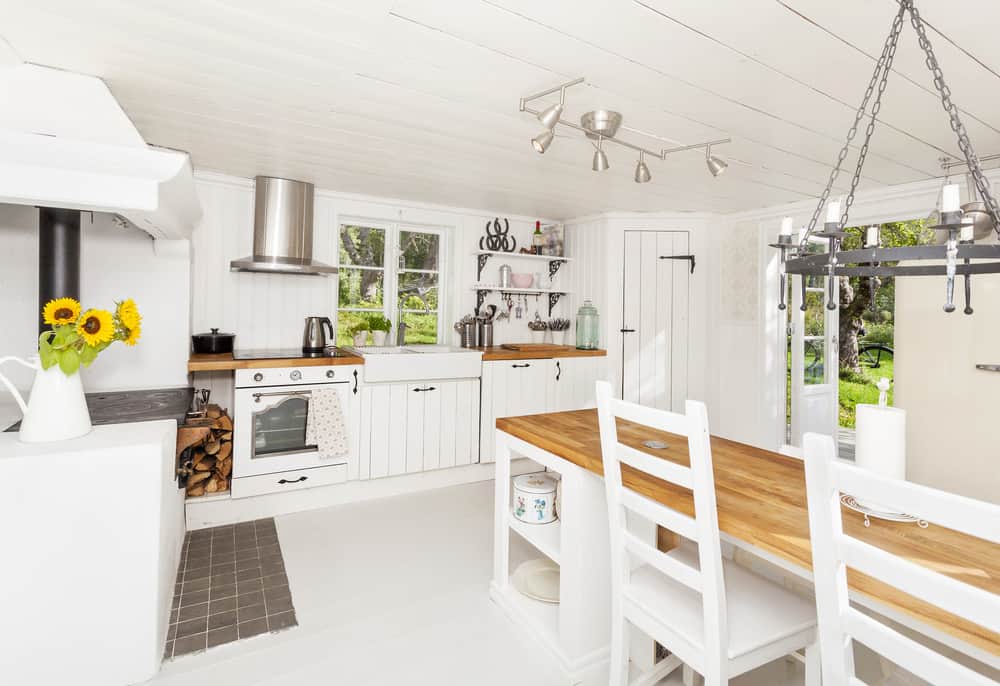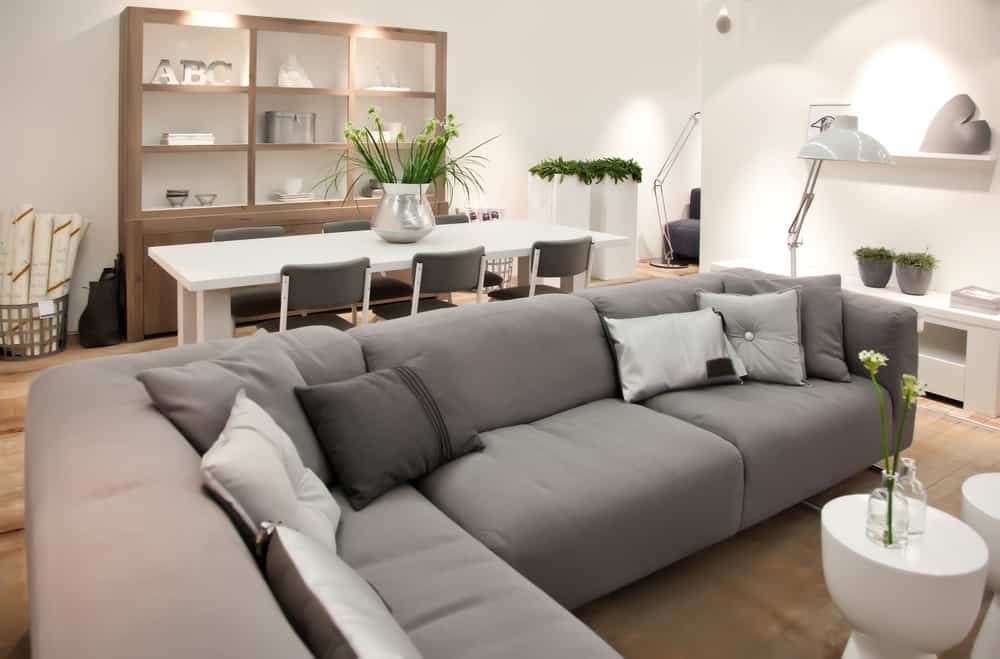Modern Interior Style
Modern style for interiors is more popular in the media than in real life. I think people appreciate the look of it and it’s definitely cool, but when it comes to living in the more austere design, people opt for warmer home decor styles such as rustic, cottage or traditional.
Nevertheless, builders and architects are incorporating modern elements to many homes which is kind of cool; but moderating it with materials, angles and lines that add warmth.
Key attributes of modern interior design style include:
- Absence of ornament,
- Intentional asymmetry,
- No clutter or chaos,
- Neutrals with primary colors and bold color contrasts,
- Geometric-patterned or plain area rugs,
- Furniture pieces have clean lines and basic shapes, made of materials like metal, chrome, or glass and are streamlined with polished, smooth and sleek surfaces,
- Art, rather than accessories, and
- Open floor plans
Contemporary Home Decor Style
Contemporary design style is often confused with modern design style… usually references to modern are in fact contemporary design.
Contemporary design is current design which includes open spaces, plenty of light, straight lines, plenty of glass, settel and wood and in some cases unusual layouts.
Elements of contemporary design:
- Open spaces or open floor plans,
- Unusual layouts,
- Use of natural light,
- Neutral colors,
- Metal accent pieces,
- Textured and natural fabric,
- Very light or very dark wood tones, and
- Lighting design used as an artistic statement.
Transitional Interior Design
Transitional interior design style is an elusive style that spans multiple styles tying traditional or long-standing styles together with modern or contemporary design elements. It’s extremely popular right now among designers. In fact, it’s very easy to confuse contemporary with transitional and in fact for both types it’s often easy to argue a particular interior design is one or the other.
Transitional interior design elements include:
- Curved furnishings with straight-lined lacquered finishes,
- Limited use of accessories,
- Use of impactful art as focal points,
- Neutral color palette, and
- Textural elements such as wood, glass, lacquer, rattan, fabric, steel and metal.
Industrial Interior Design
Industrial design became popular in the 1990’s as many North American city centers started enjoying a refurbishment by converting old manufacturing facilities and warehouses into condos and multi-unit residential buildings. Instead of covering up or removing all the remnants of the space such as brick walls, exposed pipes and electrical wires and putting in interior walls, developers created large, open units preserving the old floors, walls and keeping much of the pipes and wiring and beams exposed resulting in what is known as industrial home decor.
The key elements of industrial interior design include:
- Raw and unfinished look,
- A mix of grays, neutrals and rustic colors,
- Utilitarian objects,
- Large sectionals,
- Antique or light fixtures with metal finishes,
- Use of vintage and old factory and laboratory pieces,
- Wood and metal surfaces, and
- Concrete flooring.
Eclectic Design Style
Eclectic design is a showcasing of contrasting elements including colors, furnishings and materials. It can easily be overdone to look terrible, but when done well, the contrasting aspects can be tied together to create a cohesive and attractive design.
Main design attributes:
- Varied palette with a few grounding neutrals,
- Different pieces in the room are tied together with paint, fabric or a more refined or roughed-up finish, and
- Defined by contrasts and variety.
Beach Style

In my view the beach style should be reserved for houses on the beach. It’s kin of odd to have a nautical themed home in the burbs. This style includes light colors with splashes of bright colors such as navy blue and even bright colors, loads of natural light (i.e. windows), nautical accessories such as rope, dark wood and other items found on boats and wicker or rattan furniture.
- Light and breezy,
- Nautical-themed decor,
- All white backdrop; borrow colors from sand, surf and shells;
- Décor crafted from natural fibers and organic materials,
- Wickers tools, rattan furniture and beds with a natural oak frame, and
- Window coverings
Farmhouse Interior Design Style

Farmhouse is similar to country or rustic design styles except that it’s typically lighter, incorporates some shabby-chic, enjoys plenty of natural wood and gives an aura of a cozy feel.
Main style elements:
- All white look,
- Dominant fireplace,
- Large kitchen and dining place,
- Open shelves and cabinets,
- “Company” parlor and “family” sitting room,
- Cozy fabrics, natural materials and textiles,
- Vintage, reclaimed or heritage accessories,
- Vintage, shabby chic furniture with a rustic flair,
- Tongue-and-groove paneling, shiplap and butt boards,
- Even ceilings with exposed reclaimed beams,
- Barn doors,
- No to glass, and
- Wide plank floors.
Craftsman Style

Key interior style elements:
- Open floor plan: This is definitely a much desired design feature today and so it makes sense the Craftsman is a very popular design for contemporary homes.
- Plenty of built-in wood elements such as cabinetry, fireplace mantles, bookcases, etc.
- Plenty of handcrafted woodwork including exposed ceiling beams.
- Use of natural materials such as wood, stone, brick, glass and tile.
- Plenty of windows.
- Color scheme: earth tones and plenty of wood.



